By Richard Newman, TCA Board Member
Without initially knowing what I was doing, I recently embarked on a multiyear project to restore a small patch of the Thornton Creek Watershed. Even though I lack any formal background in ecological restoration or landscaping, I have made tremendous progress in a relatively short period of time and have learned so much along the way. To inspire other homeowners or help those who are already inspired, I am sharing my personal journey from acquiring a severely neglected plot of land to being inspired to serve as a steward of this land.
But first, a bit of background. I joined the TCA in 2019. After living in the watershed for almost 20 years, I attended a TCA public meeting about urban beavers. Beforehand, I had no idea I had once lived across the street from a beaver lodge in a greenspace now recognized as the Beaver Pond Natural Area! That there was a group educating people about the presence of beavers thriving in the city convinced me to join. The following year I joined the Board to get more involved.
Ever since moving to the Northgate area, and first exploring the watershed, it has felt incredibly familiar. This is because I spent my childhood in a watershed with very similar flora, 100 miles to the north, outside of Bellingham, WA. The subdivision in which I grew up had been built in the 1970s, a half mile uphill from Lake Whatcom, backing up against a vast second growth forest. My summers were spent with neighbor kids traversing a vast area, hunting for fungi and critters, carving trails, learning to avoid stinging nettles, felling red alders for various building projects, and later, running cross-county on endless trails.
Late in 2021, through a mix of circumstance and fortuitous timing, I was able to acquire my next-door neighbor’s property, barely a block from where 15th Ave NE crosses the south fork of Thornton Creek. He had long since abandoned his derelict home and was using it as a storage site. What had once been lawn was quickly losing ground to Scotch broom and English ivy. The brick walls of the house and portions of fence that were still standing were nearly covered in English ivy. Most of the original wooden gutters had long since rotted off the structure, and the remaining stretches still clinging to the eaves were hosting adorable licorice ferns. The prickliest of English holly bushes occupied the choicest spots throughout the property. And the steep southwestern slope was covered in a vast patch of Himalayan blackberry.
I quickly fell in love with a majestic big-leaf maple that soared over the western side of the property. But aside from that lone redeeming specimen and the adorable licorice ferns, what would I do with this veritable showcase of the worst invasive species locally?
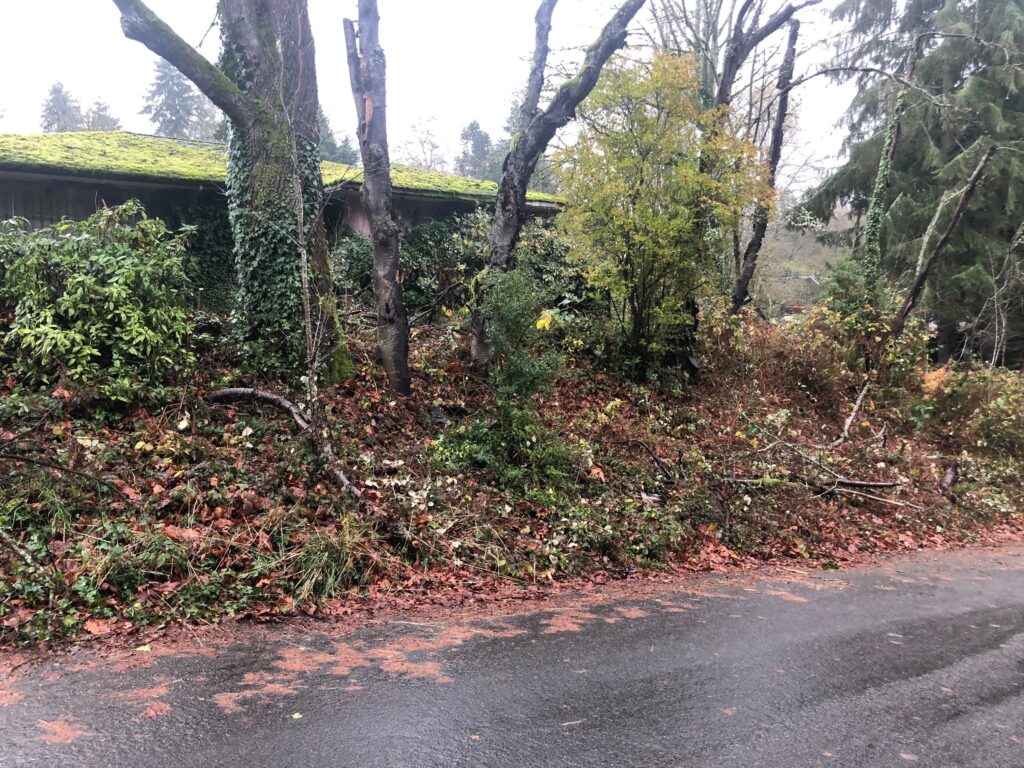
The terrain was uneven, steep in spots. Therefore, the first order of business was to create a way to gain access to all the invasives. I would need to carve trails. Creating them proved time-consuming. I had to carefully study the contours of the land and determine what would make the most sense and how best to navigate the steep parts. Over several months, I carved pathways and scraped and filled to create a perimeter trail that would allow me to service everything, both now and in the long term. I eventually cut my way through the invasives, which gave me ready access to the entire property.
Now that I could access everything, what would I do? Friends and family encouraged me to employ chemicals and machines to scorch it all and return the land to bare earth. During my prolonged examination and contemplation of the property, however, I had discovered dozens of Oregon grapes, sword ferns, and honeysuckles struggling for life under the blackberries along with several stands of osoberry and the slightly better behaved native blackberry vines. There were also healthy non-native plants, including a Portuguese laurel, Japanese privet, and numerous junipers.
So, I resisted the temptation to scorch the earth, and instead have relied mostly on elbow grease. Early on, I hired an arborist to gently prune the long-neglected maple, take down a sickly tree on the south side, and reduce the height of inadvertent snags to reduce the risk of them landing on a car in the street whenever they finally come crashing down.
I focused now on the blackberries. I ripped out scores of truly gnarly root balls (which looked like the screeching mandrakes from Harry Potter) and those I could not pull out for whatever reason, I cut and dabbed their stems with tiny amounts of herbicide. (The cut and dab method is used by practitioners to help slopes from becoming destabilized from repeated pulling at weed roots, especially when performed in small strategic patches that are then replanted and well mulched.) I then focused on numerous holly bushes, invasive hawthornes, and Scotch broom. Finally, I started tackling the seas of English ivy, filling countless compost bins. After a year plus of persistent effort, I am finally beginning to see the end of this initial phase of making breathing room for what was already here as well as space for a more diverse palette to come.
After living next door for 15 years, and having had my soil tested, I had a pretty good idea about its attributes. Further, the invasives served as “indicator species,” confirming that the land consisted of dry sandy soil (no sign of any invasive buttercup or other moisture lovers). Since the soil had not been cared for during the time I had lived next door, I knew it would need copious amounts of organic matter to support new life. Therefore, I set about adding organic matter and mulching with wood chips available for free from chipdrop.com (six loads of wood chips and counting).
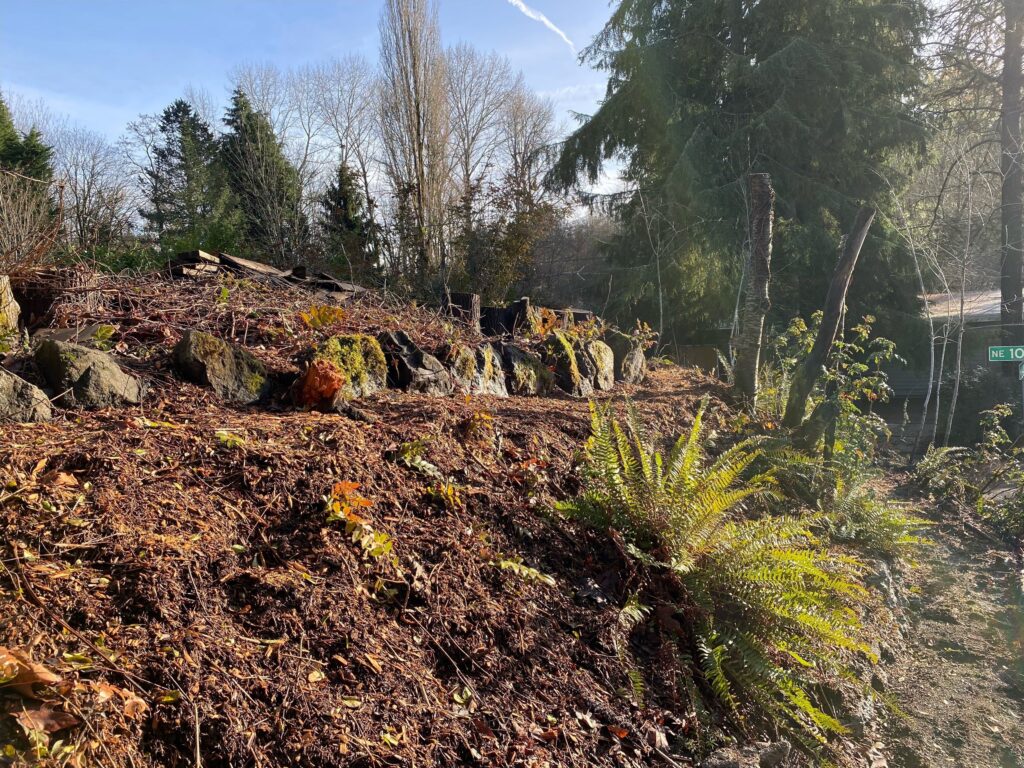
Without really knowing what I would ultimately do, I found myself fantasizing about restoring the plot of land to what it might have looked like prior to the arrival of white settlers in the mid-1800s. I started researching and reading books about restoring the land to better support the critters. Sara Stein’s book Noah’s Garden was particularly inspiring. Her argument is basically that aware and concerned homeowners should think of their yards and gardens as “arks” able to contain the remaining vestiges of native species. Planting a diverse mix of natives (or at least including some) supports local fauna. This does not mean that there can’t also be space for non-native species, but that natives are emphasized to benefit the animals. It’s all very straightforward, but she described her own experience doing so and thus presented the concept in an intuitive way.
Among the best resources was a webpage King County maintains with guidance for how to landscape a steep slope with dry sunny conditions: https://green2.kingcounty.gov/gonative/Plan.aspx?Act=view&PlanID=535
Using this website as a guide, and consulting a fellow TCA Board member involved in restoration work, I recently ordered nearly 100 native trees, shrubs, and groundcovers from the King County Conservation District, including kinnikinnik, salal, and oceanspray. If all goes well, by April, my tiny patch of the watershed ought to be recovering and thriving into a wonderland for insects, birds, and small mammals as well as the people who live here and pass by every day.
The project is far from over and may not really be apparent for several years. Nonetheless, the journey thus far has been incredibly rewarding and no matter how things go, I know I have already left the land in far better shape than I found it.
More After Images and Resources are Below
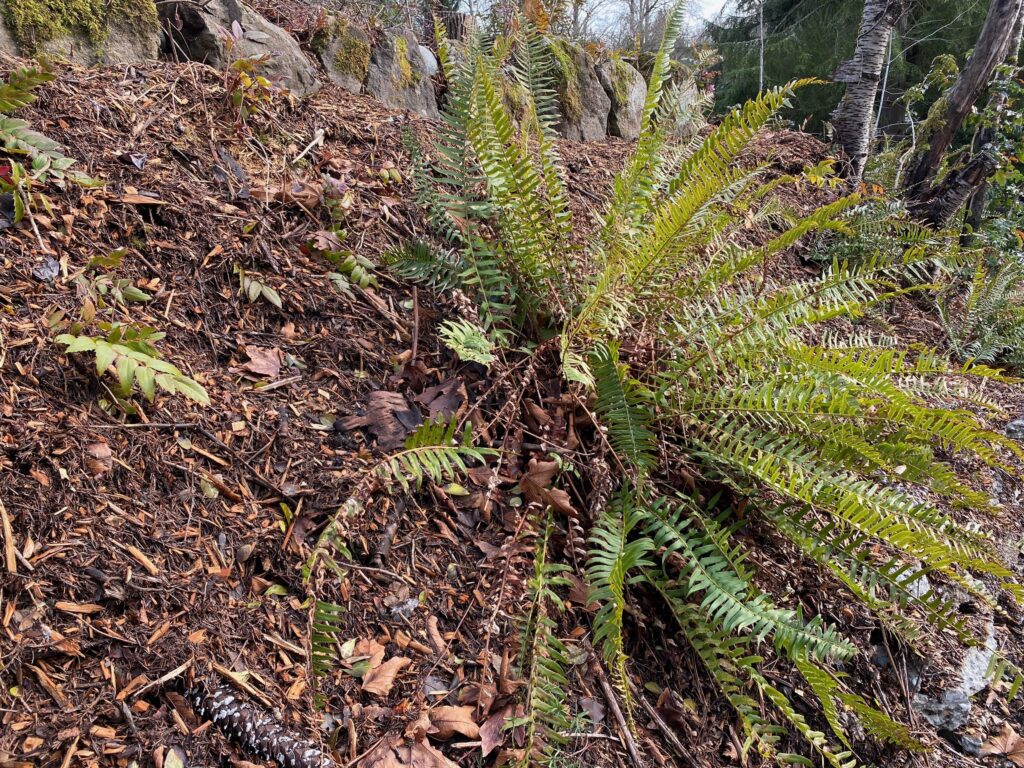

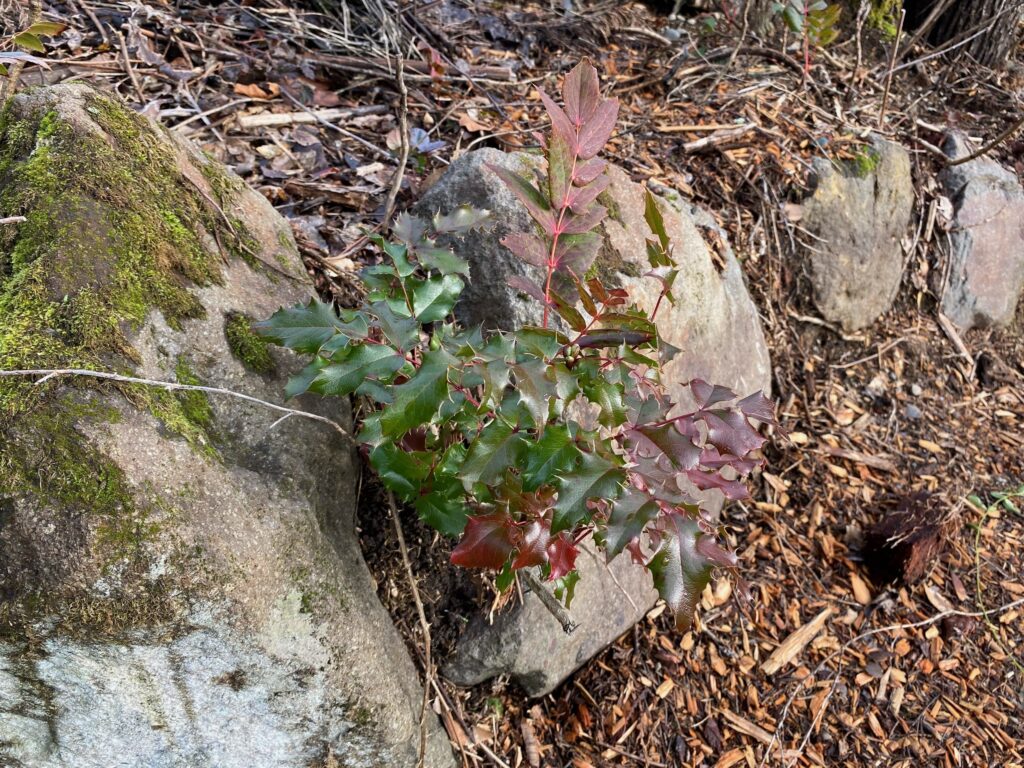
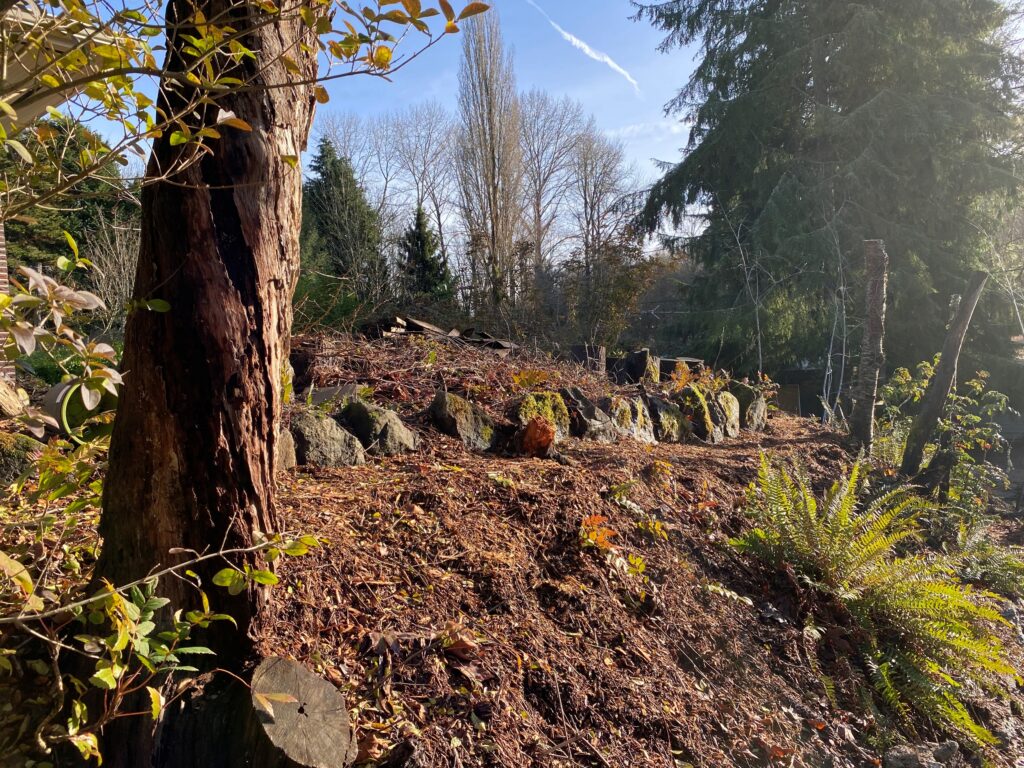
Resources for Potential Restorations
| Date & time | Name | Location | Description |
| Ongoing online, open since Nov 15, 2022 | King County Conservation District Native Bareroot Plant Sale | Pickup is March 4 and 5 at Tukwila Community Center, 12424 42nd Ave S, Tukwila, 98168. | Preorder online sale only. Order early as some items do sell out well in advance of the deadline. There will not be a walkup sale or community fair. Variety of native trees, groundcovers and shrubs for conservation purposes, most bareroot. |
| Sunday, March 26, 10 am to 2 pm | March Mania Plant Sale 2023 | Bellevue Botanical Garden, 12001 Main St, Bellevue, 98005 | March is a great time to buy plants from a select group of local small nurseries and specialty growers who sell an amazing collection of hard-to-find and old-time favorite perennials, shrubs, ferns, grasses and more. Your support helps these growers thrive and prosper, and in return they can grow even more special plants for our gardens!This is a Farmer’s Market Style plant sale where you purchase plants directly from each seller — bring your own small wagon/cart to carry your purchases back to your car. |
| April 8, 2023 from 10:00 am to 2:00 pm | Northwest Chapter of the North America Rock Garden Society (NWNARGS) | Bellevue Botanical Garden, 12001 Main St, Bellevue, 98005 | Rare plants from around the world and northwest natives will be on sale at the Bellevue Botanical Garden from 10 am until 2 pm. on Saturday, April 8. Volunteers and donors-only presale 9.30–9:45 am; all members’ presale begins at 9:45 am. Non-members can join at the sale! |
| Saturday, April 8, 2023 (tentative) 10 am to 2 pm | Washington Park Arboretum Spring Plant Sale 2023 | Graham Visitors Center, 2300 Arboretum Dr. E, Seattle 98112 | On Saturday, April 8, the nursery will re-open for the season (April through October), and the greenhouse will be back operating at full capacity. Volunteers will be onsite to help you with plant selections and share more about these volunteer run plant programs. |

